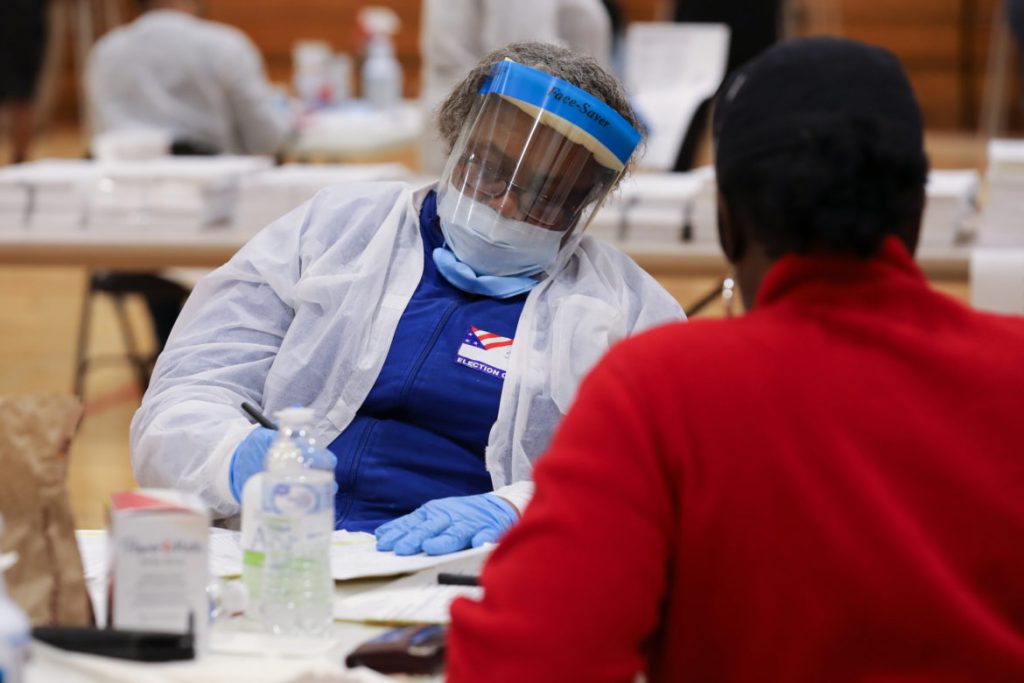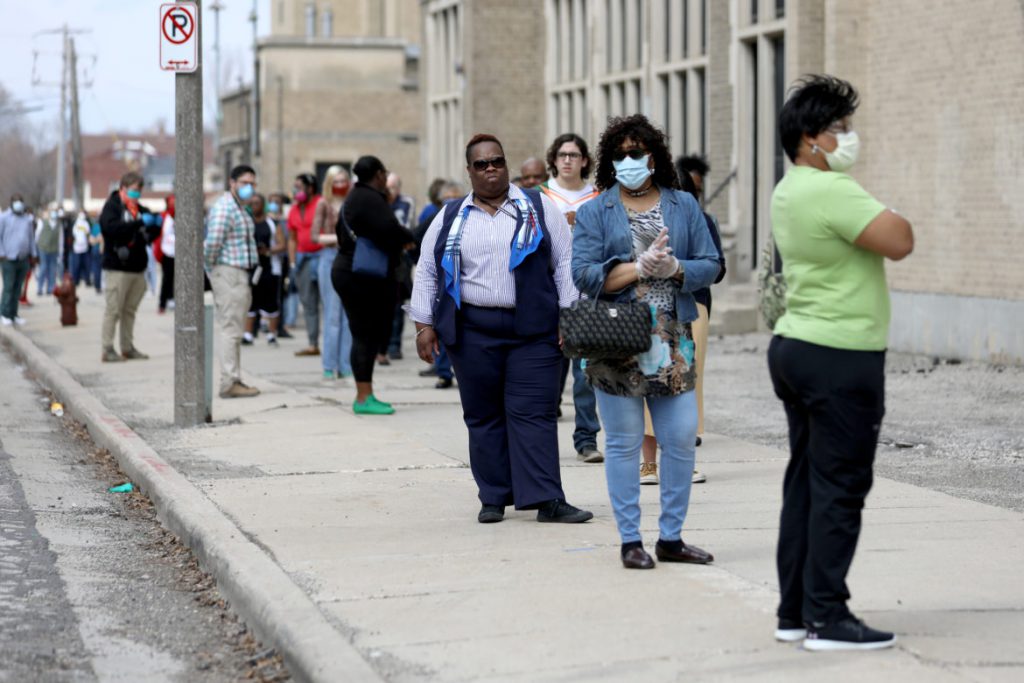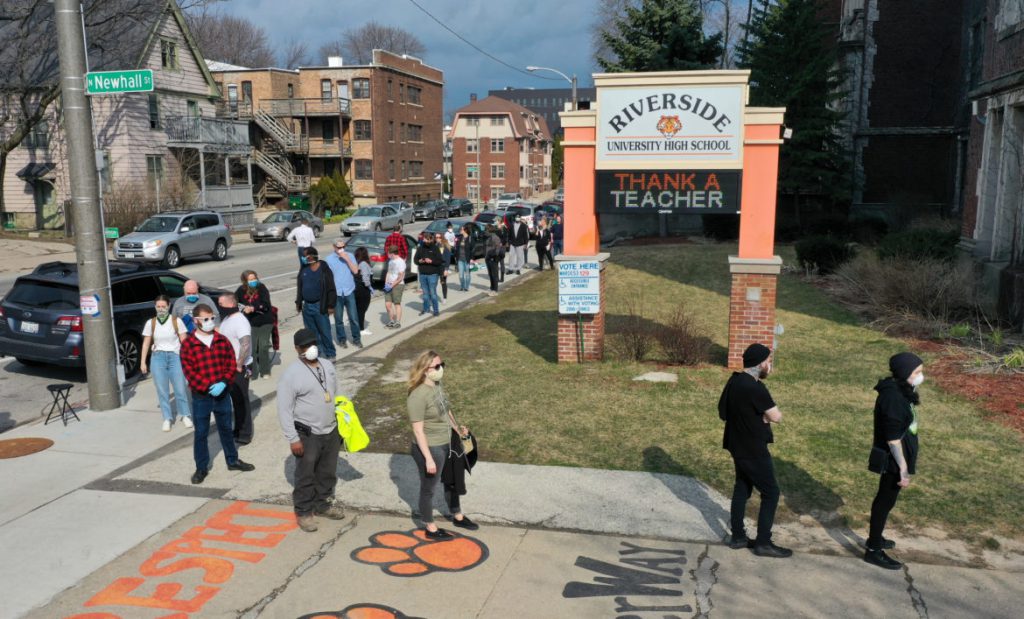Pandemic Reduced Black Vote, Study Finds
Study finds lack of polling places, fear of COVID-19 reduced April turnout of Black city voters by nearly 10%.

A poll worker wearing protective gear assists a voter at Marshall High School in Milwaukee on April 7, 2020. A new study from the Brennan Center for Justice estimates that consolidating the city’s polling sites down to five from 182, and voter fears of contracting the coronavirus, depressed voting by 9.9 percentage points among non-Black voters and 15.9 percentage points among Black voters. Photo by Coburn Dukehart/Wisconsin Watch.
Significant numbers of Milwaukee voters were dissuaded from voting on April 7 by the sharp reduction in polling places and the threat of the COVID-19 pandemic — with the biggest effects seen among Black voters, according to a new study.
Researchers from the Brennan Center for Justice say their study is the first to measure the impact of the pandemic on voting behavior. The study found that Milwaukee’s decision to close all but five of its 182 polling places reduced voting among non-Black voters in Milwaukee by 8.5 percentage points, and that COVID-19 may have further reduced turnout by 1.4 percentage points. That would mean the overall reduction in turnout among non-Black voters was 9.9 percentage points.
Black voters experienced more severe effects: Poll closures reduced their turnout by an estimated 10.2 percentage points, while other mechanisms — including fear of contracting COVID-19 — lowered turnout by an additional 5.7 percentage points. Those factors combined to depress Black voter turnout by 15.9 percentage points, the researchers estimated.
Overall, turnout in the city for the election — which determined a hotly contested Wisconsin Supreme Court race and the state’s Democratic nominee for president — was 32%, according to the Milwaukee Election Commission.
The Brennan Center study raises concerns about disenfranchisement in November, especially among Black residents, as voters choose the president and members of Congress and the Wisconsin Legislature. And it raises fresh doubt about how well states like Wisconsin, which does not have a tradition of widespread absentee balloting, will ensure that all residents can vote in November without exposing themselves to a deadly disease.

Voters waited for hours in long lines to vote in Milwaukee on April 7, 2020. Here, the voting line wraps around the block outside Washington High School. Researchers say that consolidating polling sites and health concerns of voting in-person during the pandemic kept many Milwaukee voters away, especially Black residents. Photo by Coburn Dukehart/Wisconsin Watch.
The study examined the impact of the city of Milwaukee’s decision to close all but five of its usual polling sites on April 7 due to lack of available poll workers and the effect of conducting a statewide election during a pandemic.
“It is a big effect, and it should make administrators perk up and realize we need to make access to the ballot easier, not harder, this fall,” said researcher Kevin Morris, who conducted the study with fellow researcher Peter Miller for the Brennan Center, a New York University Law School-based center that advocates for changes to improve democracy.
Among those who stayed away from the polls on April 7 was Paula Durrell, a 64-year-old retired breast cancer survivor. The Milwaukee resident told the Milwaukee Neighborhood News Service that the election forced her to choose between her right to vote and protecting her health. She chose the latter.
The study compared voters in Milwaukee with those in the rest of Milwaukee County, in Racine County and in the conservative-leaning “WOW” counties of Washington, Ozaukee and Waukesha. The study “genetically” matched each city voter with two similar voters in adjacent areas by party affiliation, gender, household income, education and race/ethnicity.
At the time of the election, those other counties were experiencing COVID-19 infection rates far below the rate of 14 per 10,000 residents in Milwaukee County — the hotspot of infection in Wisconsin. And none of them consolidated polling places as aggressively as did the city of Milwaukee.
Previous studies have shown that closing or moving polling places farther away can depress voter turnout. The report credits fears over the pandemic with even further suppressing the vote on April 7.
“Turnout in Milwaukee was apparently depressed by mechanisms above-and-beyond those explained by polling place consolidation and the voter demographics,” the researchers concluded. “Milwaukee was hard-hit by the COVID-19 crisis; this analysis demonstrates that COVID-19 directly depressed turnout in Milwaukee City.”
Milwaukee Election Commission Executive Director Neil Albrecht said the city drastically consolidated polling places after the usual election staff of 2,200 was cut to 300 because of the “unparalleled” level of fear of the pandemic. Albrecht blamed the Legislature for pushing ahead with the election, which he said “put the lives of Milwaukee residents at risk.”

The voting line wraps around the block outside Riverside High School in Milwaukee during the primary election on April 7, 2020. A new report says the city’s voter turnout was strongly depressed by Milwaukee’s decision to reduce its normal 182 polling sites to five and voter fears of contracting COVID-19. Photo by Coburn Dukehart/Wisconsin Watch.
Officials in Milwaukee and around Wisconsin took numerous measures to improve safety at the polls, including using plexiglass barriers, face masks and shields, allowing voters to stay in their vehicles to vote, enforcing social distancing and offering plenty of hand sanitizer.
How the election affected public health is unclear.
The state Department of Health Services found 71 Wisconsites got COVID-19 after voting or working at the polls, the Wisconsin State Journal reported last month. But those people could have been exposed in other ways, health officials said.
Both studies were released before being peer-reviewed.
The Brennan Center researchers said their study raises concerns about racial representation in the November election as voting shifts more to absentee balloting, which is less often used by racial minorities — who studies show are more likely to have their absentee ballots rejected.
A record-smashing 1.1 million-plus absentee ballots were cast statewide on April 7 — four times the amount requested in the previous spring presidential primary in 2016. But that shift did not offset the drop in in-person voting, the researchers found.
Wisconsin Watch found that some voters warily went to the polls after requesting absentee ballots that never came — or decided reluctantly to stay home.
Albrecht said he expects Milwaukee will open most if not all regular voting sites for the Aug. 11 partisan primary and the Nov. 3 general election. Anticipating a large demand for vote by mail, the Wisconsin Elections Commission also plans to send absentee ballot applications to 2.7 million registered voters ahead of the November election.
“Voters will not seamlessly transition to vote by mail,” the Brennan Center researchers cautioned, “and polling place closures this fall will come at the expense of turnout — particularly the turnout of Black Americans.”
The nonprofit Wisconsin Watch (wisconsinwatch.org) collaborates with WPR, PBS Wisconsin, other news media and the UW-Madison School of Journalism and Mass Communication. All works created, published, posted or disseminated by Wisconsin Watch do not necessarily reflect the views or opinions of UW-Madison or any of its affiliates.
More about the 2020 Spring Primary
- Why Don Natzke Couldn’t Vote - Enjoyiana Nururdin - Aug 9th, 2020
- Centers for Disease Control and Prevention’s Morbidity and Mortality Weekly Report highlights public health measures taken by the Milwaukee Health and Fire Departments, Department of Administration, Election Commission, and the Wisconsin Department of Health Services - City of Milwaukee Health Department - Aug 4th, 2020
- CDC Says Election Did Not Cause COVID-19 Spike - Erik Gunn - Aug 4th, 2020
- Pandemic Reduced Black Vote, Study Finds - Dee J. Hall - Jun 25th, 2020
- Did April Election Hike COVID-19 Cases? - Alana Watson - May 20th, 2020
- Elections Commission Notes ‘Lessons Learned’ - Henry Redman - May 19th, 2020
- Wisconsin Elections News: WEC Releases Analysis of Absentee Voting in April 7 Spring Election - Wisconsin Elections Commission - May 18th, 2020
- Election’s Impact on County’s COVID-19 Cases Unclear - Jeramey Jannene - May 6th, 2020
- Why State’s Voting By Mail Was Chaotic - Daniel C. Vock - May 4th, 2020
- At Least 40 COVID-19 Cases Tied to Election in Milwaukee - Graham Kilmer - Apr 24th, 2020
Read more about 2020 Spring Primary here
More about the Coronavirus Pandemic
- Governors Tony Evers, JB Pritzker, Tim Walz, and Gretchen Whitmer Issue a Joint Statement Concerning Reports that Donald Trump Gave Russian Dictator Putin American COVID-19 Supplies - Gov. Tony Evers - Oct 11th, 2024
- MHD Release: Milwaukee Health Department Launches COVID-19 Wastewater Testing Dashboard - City of Milwaukee Health Department - Jan 23rd, 2024
- Milwaukee County Announces New Policies Related to COVID-19 Pandemic - David Crowley - May 9th, 2023
- DHS Details End of Emergency COVID-19 Response - Wisconsin Department of Health Services - Apr 26th, 2023
- Milwaukee Health Department Announces Upcoming Changes to COVID-19 Services - City of Milwaukee Health Department - Mar 17th, 2023
- Fitzgerald Applauds Passage of COVID-19 Origin Act - U.S. Rep. Scott Fitzgerald - Mar 10th, 2023
- DHS Expands Free COVID-19 Testing Program - Wisconsin Department of Health Services - Feb 10th, 2023
- MKE County: COVID-19 Hospitalizations Rising - Graham Kilmer - Jan 16th, 2023
- Not Enough Getting Bivalent Booster Shots, State Health Officials Warn - Gaby Vinick - Dec 26th, 2022
- Nearly All Wisconsinites Age 6 Months and Older Now Eligible for Updated COVID-19 Vaccine - Wisconsin Department of Health Services - Dec 15th, 2022
Read more about Coronavirus Pandemic here

















